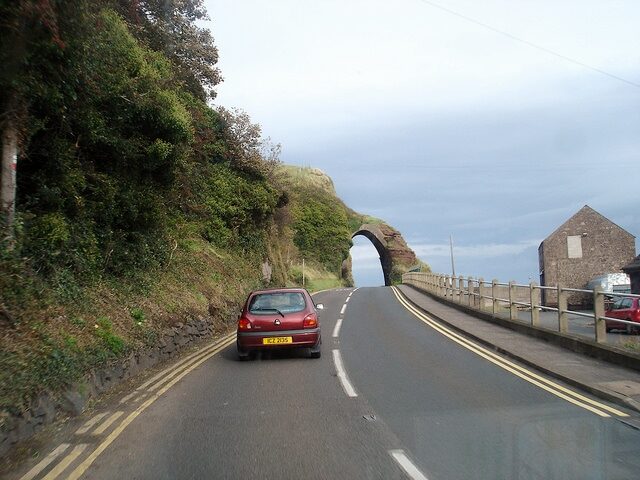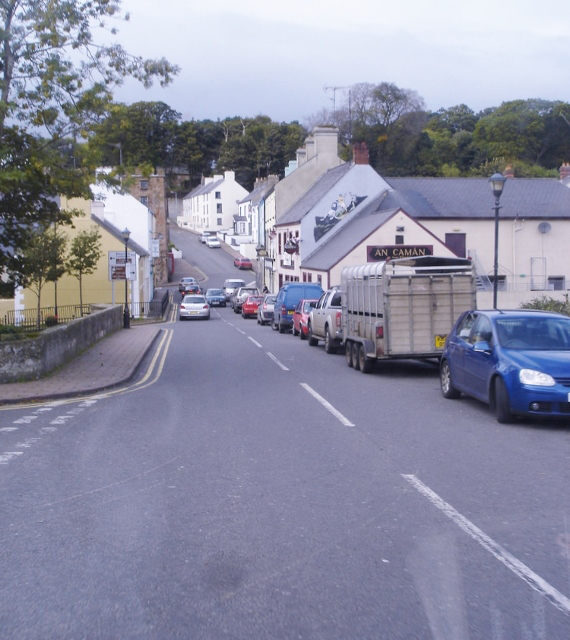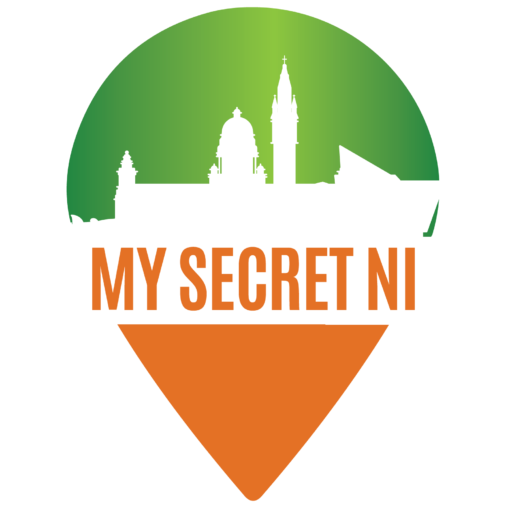
Northern Ireland Travel – Driving in Ireland and Northern Ireland
This page is specifically for driving in Ireland and across the border to Northern Ireland.
Adjustments you have to make
- What side of the road does northern Ireland drive on? Both in Northern Ireland and Ireland the you drive on the left hand side of the road in line with the rest of Britain. Although there are some different rules and laws ion Northern Ireland and Ireland this is the norm..
Drivers from continental Europe will have to adjust to driving on the left side as well as using miles instead of kilometers.
American drivers will have to adjust to driving on the left side, and driving in (sometimes) very small roads. I have met many an American driver who found it a challenge to drive in Ireland and Northern Ireland. They quickly get used to it, though, and thoroughly enjoy it.
Remember, in Northern Ireland it is prohibited to talk to your mobile/cell phone while driving. You will get a hefty penalty and 3 points on your driving license.
So, wherever you come from, read on!

Road System
Motorways are limited to the immediate vicinity of Belfast, in Northern Ireland and while driving in Ireland, you will meet motorways around Dublin. They are marked by the letter M followed by a numeral. E.g. M2.
“A” roads are next in size and connect most of the main cities. Some A roads like the A1 going south from Belfast to Banbridge, Newry and joining the M1 in the Republic, or the A8 going from Belfast to Larne are mostly dual carriageways and fairly efficient. Other A roads are smaller and more given to congestion. If you are planning trips to/from Enniskillen or Londonderry, be prepared for slow progress at times.
Beyond the M and A roads there is a multitude of smaller roads that connect everything to everywhere. Often very scenic, they are also very narrow and not always well signposted.
Farm traffic is common and can slow things substantially. If you live a fast paced life you might find it frustrating. But chill out! You are on holiday and when in Northern Ireland do as the Northern Irish do! Do not honk, do not get upset, wait patiently and wave politely when the road clears. This way you will make good friends quickly.
Driving Licence
To drive in Northern Ireland you will have to have a Valid UK driving licence, international driving permit or an official driving licence issued by your home country. It is worth keeping a copy of your driving licence or international driving permit in a safe place and carry your actual licence with you as you may be asked to produce it by the authorities or car rental companies.
Some further information that you may find interesting is that in both the UK and Republic of Ireland, there are two different types of licence. Full and for Automatic cars. If you only have licence to drive an automatic car (non stick shift) then you can only drive these.
There is also a minimum age for driving in both the Republic of Ireland and Northern Ireland, which is 17. Therefore if in your country you can drive younger than this you will not be legally allowed to drive in ireland.
Motor Insurance
Across the Emerald Isle there is a requirement to have vehicle insurance and normally to carry a motor insurance certificate, however, most Uk vehicle insurance providers send this electronically, they also provide an insurance green card that covers you in Ireland as well.
If you are driving your own car, there are three types of
Comprehensive cover – this is the highest level of motor insurance and covers most incidents
Third-party fire and theft cover – This cover, as the name suggests, covers your car against incidents where your car is stolen or burned out.
Third party insurance – This is the lowest insurance level and the minimum requirement for driving in Ireland. However, it only generally covers other road users that you have an accident with.
Speed Limits
Northern Ireland’s speed limits are in miles per hour, unlike Ireland, that has its speed limits in Kilometres Per Hour. In general with the exception of built up areas the speed limits are clearly signposted with circular road signs displaying speed limits in black writing with red rim. The only exception to this will be on national roads ie country roads, where the national speed limit will be displayed by white road signs with black angled band across it (see below)
Maps and Navigation
If you are tech savvy, ensure you have a good satellite navigation system. Emphasis on the word “good” because until recently Northern Ireland was not well mapped out in satellite navigation systems, sometimes leading to confusing directions. I understand things have rapidly improved.
If you get lost, don’t be embarrassed to ask for directions. The people are very friendly and they will happily help you out. In fact, while asking for directions we met a gentleman who got into his car and led us all the way to the place we wanted to go!
With or without a satellite navigation system, it is wise to have a good old-fashioned road map. It is inexpensive and widely available. You can buy it from any Gas Station/Garage/Petrol station, any big supermarket or Newsagent and even online.
Petrol (Gas) Stations
In Northern Ireland there are usually two types of fuel: diesel and petrol. Petrol is what Americans would call Gas. Both are quite expensive (in comparison to America) so many Northern Irish opt for diesel-engined cars which usually get better mileage per gallon. If you rent a car ensure you use the right fuel. Wrong fuel can damage the engine.
Petrol stations are self-service which means you have to fill your own vehicle up. In most cases you first fill up and then pay in the shop. Ensure you have the means to pay before you fill up. Most stations have cameras so don’t think of filling and driving away without paying. In few stations or late at night, you might have to pay in advance. In the Republic in most petrol stations someone will fuel your vehicle for you.
Most petrol stations have a store attached so you can buy most necessary things including food and some over the counter medicine if supermarkets are closed. If you have babies this might be a great help if suddenly you discover you are out of nappies (diapers) or have lost that precious last dummy (pacifier) for the baby.
Save money on Fuel while driving in Ireland and Northern Ireland
Money saving tip 1
Fuel in the the Republic of Ireland has traditionally been cheaper. Northerners who live close to the border will regularly travel across the border to buy cheaper fuel. If you are travelling from the Republic towards Northern Ireland, it might be worthy to stop and fill the tank of the car before you cross the border.
Money saving tip 2
Beware of cowboys! Fuel (especially diesel) can be adulterated. If you plan to go to be driving in Ireland for fuel, ask a Northerner who does the trip regularly where best to buy. If you don’t know anyone, ask at the hotel reception or the B&B or Cottage owner where you are staying.
Money saving tip 3
If you plan to pay by credit or debit card, beware! The petrol station salesperson might ask you what currency you want to pay in, Euro or Sterling. Most don’t offer the option of US dollars.
My advice is, always choose Euros even if your card is in Sterling. The reason is that petrol stations will offer there own exchange rate which is usually much worse than the bank’s. There will be a statement to that effect on your receipt, but by the time you see it is too late, you have already paid. In which case you might end up paying as much (or more?) than if you had bought your fuel in Northern Ireland.
Driving in Ireland and Northern Ireland: Across the Border
Northern Ireland and the Republic of Ireland (Southern Ireland) are two distinct national entities. While membership in the European Union has done away with elaborate border crossings, by driving from one into the other you are going from one country to another. Most times you won’t notice. If, for example, you are driving in Ireland from Cavan to Armagh in Northern Ireland via Rosslea, you will cross the border no less than seven times in the space of 50 miles!
The easiest way to tell when you have crossed is to look at the color of the lines on the road. If on the side of the road you see yellow lines you are in the Republic. If you see white lines, most likely you are in the North.
While there are no border posts, there might be occasional police checks so ensure you have your passport or other ID and that your visa (if you need one)is valid for both parts.
Tolls
Northern Ireland does not have tolls on the road. When driving in Ireland you will meet toll booths in major Motorways. If you are planning a trip to the South ensure you have some change in Euros. While they might accept Sterling on certain cases, they will charge more.
Road and Traffic
The direction of driving in Ireland is left, just like in Northern Ireland (thankfully!). However, be aware distances and speed limits in the South are in kilometers, while in the North in miles. The police in the South is called Garda.
Roads and traffic in the South are worse than in the North. I recall setting out on a trip to Ennis thinking that the 190 miles might take four hours. Six hours later I was still negotiating my way through traffic. The signposting on secondary roads can be very incomplete, though, overall, the government is trying hard to improve the infrastructure. So, if you are travelling South, for example following our Across the Border tour suggestions, ensure you have a good map and plenty of patience.
Driving direction in UK and Northern Ireland.
We drive on the left side of the road! For more information on how to keep to the left, and to find out who has priority on a roundabout, which is the fast lane, what are the speed limits, check out the Driving direction in UK page here.
Roadblocks
Occasionally you will see armed police on the road stopping cars and checking people. Don’t panic (unless you have reason to!!).
This was normal during the Troubles, less so. In the past 25 five years. In my old career, I used to travel all over Ireland & Northern Ireland and came across maybe a dozen or so roadblocks.
The majority of these road blocks are not actually the police but the local department of transport checking for red (green in the south) deisel…as this is cheaper as its for agricultural use. Just stop when they ask you to and show some ID. They are usually very polite and might even give you directions to avoid traffic if there is any bottleneck.
Seatbelt safety while driving in Ireland and Northern Ireland
The law in Northern Ireland is very strict about seat belts. Please read our laws on Seat belts article as passengers and the driver not wearing seat belts in all cars is a very serious offence.
Drunk driving
It is a serious offense in both Northern Ireland and the Republic of Ireland to drive under the influence of alcohol. Do read about drink driving in Northern Ireland here.
Using Your Phone While Driving
This has become a bigger and bigger issue in Northern Ireland. Using you phone (Mobile/Cell) while driving, for phone calls, texting or even as a sat nav is an offence and can land you with a fine and points on your licence.
Return from Driving in Ireland to Northern Ireland Tourism Homepage

